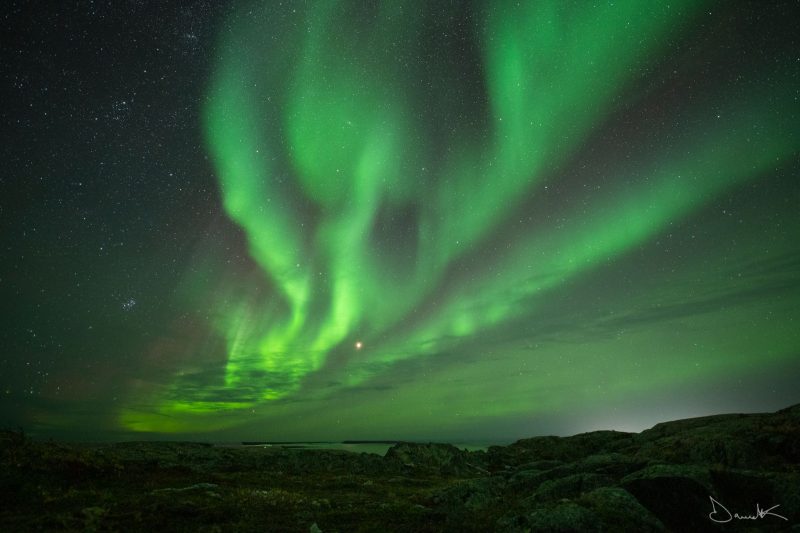
Jupiter X-ray aurora mystery solved
So you think Earth’s northern lights are big and majestic? In July 2021, Randy Gladstone of the Southwest Research Institute in San Antonio, Texas, said in a NASA statement:
That’s nothing … Jupiter has auroras bigger than our entire planet.
In that statement, planetary astronomers were announcing that they’d just solved a 40-year-old mystery about the origins of Jupiter’s unusual X-ray auroras. They did it by combining measurements from NASA’s Juno spacecraft – now in orbit around Jupiter – with data from the European Space Agency’s Earth-orbiting XMM-Newton mission. For the first time, these scientists said, they’ve seen the entire aurora-making mechanism at work. They’ve seen that electrically charged atoms, or ions, responsible for the X-rays are surfing electromagnetic waves in Jupiter’s magnetic field down into the gas giant’s atmosphere.
The peer-reviewed journal Science Advances published this new work earlier this month.
What makes an aurora?
Maybe you’re familiar with earthly auroras. They are colorful displays of light in the skies visible from high latitudes. The aurora borealis shines within the Arctic Circle of Earth’s Northern Hemisphere. The aurora australis shimmers above the Antarctic Circle down south. People far and wide travel to see these glorious lights, and to marvel at them.
On Earth, the aurora is a product of a natural process by which electrically charged particles, or ions, ejected from the sun collide with oxygen and nitrogen atoms in Earth’s atmosphere.
Auroras, and the processes that create them, can be found throughout our solar system. Scientists know of auroras on seven of our sun’s planets. Some are visible to the human eye. Others require specialized telescopes to be seen. Jupiter has the most powerful auroras in the solar system. And that’s not surprising, since it’s our solar system’s most massive planet.
But Jupiter is the only one of the four giant planets with an aurora that has been found to emit X-rays.

Why it’s mysterious
Jupiter’s auroras are unusual. They’ve had scientists scratching their heads since NASA’s Voyager 1 space probe first discovered them in 1979. Scientists have studied and scrutinized Jupiter’s auroras since then. NASA explained why:
… it was not immediately clear how the energy required to produce [Jupiter’s x-rays aurora] is generated. They knew these surprising Jovian northern and southern lights are triggered by ions crashing into Jupiter’s atmosphere. But until now scientists had no idea how the ions responsible for the X-ray light show are able to get to the atmosphere in the first place.
At Earth, auroras are usually visible only in a belt surrounding the magnetic poles, between 65 and 80 degrees latitude. Beyond 80 degrees, auroral emission disappears because the magnetic field lines leave Earth and connect to the magnetic field in the solar wind … Jupiter’s X-ray auroras are different. They exist poleward of the main auroral belt and pulsate …
Scientists studying the phenomena turned to computer simulations and found that the pulsating X-ray auroras could be linked to closed magnetic fields generated inside Jupiter. Those fields stretch out millions of miles into space before turning back. But how to prove the model was viable?
Solved after 40 years
Both ESA’s XMM-Newton telescope and NASA’s Juno probe played roles in uncovering this mystery. XMM-Newton operates in Earth orbit, remotely observing Jupiter at X-ray wavelengths. In July 2017, it observed Jupiter for 26 hours and determined that its X-ray auroras pulsate every 27 minutes.
Juno is in orbit around Jupiter, taking readings from inside the giant planet’s magnetic field. It hunted for any clues about magnetic processes occurring at the same rate. What Juno found is that fluctuations in Jupiter’s magnetic field cause the pulsating X-ray auroras.
Like Earth, Jupiter rotates and drags its magnetic field with it at the same time. Solar ions directly strike the magnetic field. Compression of heated particles trapped within the field triggers a phenomenon called electromagnetic ion cyclotron (EMIC) waves. These particles follow along the warped field lines. Guided by the field, the ions surf the EMIC wave and then slam into the atmosphere, triggering auroras.
For the first time, astronomers could see the entire mechanism at work. Ions surf the compressed waves in Jupiter’s magnetic field, smack the atmosphere, and spark an ethereal phenomenon of extraordinary beauty: an aurora.
William Dunn, of University Collect London, who co-led the research, said:
What we see in the Juno data is this beautiful chain of events. We see the compression happen. We see the EMIC wave triggered. We see the ions, and then we see a pulse of ions traveling along the field line. And then a few minutes later, XMM sees a burst of X-rays.
On to the rest of the solar system
Now that the process behind Jupiter’s auroras is solved, it raises the question: Where could scientists study it next?
Io, the innermost of the four Galilean moons of Jupiter, spews sulfur and oxygen into its magnetic field. Saturn’s moon Enceladus jets water into space, which fills its magnetic field with water ions. In other words, the composition of the process isn’t uniform across the solar system. Yao says:
This is a fundamental process that’s applicable to Saturn, Uranus, Neptune, and probably exoplanets as well.
Dunn added:
It could be that EMIC waves play an important role in transferring energy from one place to another across the cosmos.
The study of Jupiter’s auroras isn’t over yet. ESA’s JUpiter ICy moons Explorer, aka Juice, is currently in development and scheduled to arrive at the planet by 2029. The interplanetary spacecraft will study its atmosphere and magnetosphere, and the effects of Jupiter’s four largest moons on its auroras.
Bottom line: For the first time, astronomers have seen the entire mechanism of what causes Jupiter’s X-ray auroras at work. And it could be a process occurring in many other parts of the universe, too.
Source: Revealing the source of Jupiter’s x-ray auroral flares











